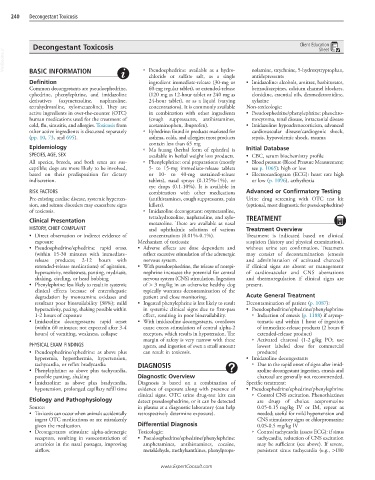Page 537 - Cote clinical veterinary advisor dogs and cats 4th
P. 537
240 Decongestant Toxicosis
Decongestant Toxicosis Client Education
Sheet
VetBooks.ir
BASIC INFORMATION
○ Pseudoephedrine: available as a hydro-
chloride or sulfate salt, as a single nolamine, strychnine, 5-hydroxytryptophan,
antidepressants
Definition ingredient immediate-release (30-mg or • Imidazoline: alcohols, amitraz, barbiturates,
Common decongestants are pseudoephedrine, 60-mg regular tablet), or extended-release benzodiazepines, calcium channel blockers,
ephedrine, phenylephrine, and imidazoline (120 mg as 12-hour tablet or 240 mg as clonidine, essential oils, dexmedetomidine,
derivatives (oxymetazoline, naphazoline, 24-hour tablet), or as a liquid (varying xylazine
tetrahydrozoline, xylometazoline). They are concentrations). It is commonly available Non-toxicologic:
active ingredients in over-the-counter (OTC) in combination with other ingredients • Pseudoephedrine/phenylephrine: pheochro-
human medications used for the treatment of (cough suppressants, antihistamines, mocytoma, renal disease, intracranial disease
cold, flu, sinusitis, and allergies. Toxicosis from acetaminophen, ibuprofen). • Imidazoline: hypoadrenocorticism, advanced
other active ingredients is discussed separately ○ Ephedrine: found in products marketed for cardiovascular disease/cardiogenic shock,
(pp. 10, 73, and 695). asthma, colds, and allergies; most products sepsis, hypovolemic shock, trauma
contain less than 65 mg
Epidemiology ○ Ma huang (herbal form of ephedra) is Initial Database
SPECIES, AGE, SEX available in herbal weight loss products. • CBC, serum biochemistry profile
All species, breeds, and both sexes are sus- ○ Phenylephrine: oral preparations (mostly • Blood pressure (Blood Pressure Measurement;
ceptible; dogs are more likely to be involved, 5- to 15-mg immediate-release tablets see p. 1065): high or low
based on their predisposition for dietary or 10- to 40-mg sustained-release • Electrocardiogram (ECG): heart rate high
indiscretion. tablets), nasal sprays (0.125%-1%), or or low (p. 1096), arrhythmia
eye drops (0.1-10%). It is available in
RISK FACTORS combination with other medications Advanced or Confirmatory Testing
Pre-existing cardiac disease, systemic hyperten- (antihistamines, cough suppressants, pain Urine drug screening with OTC test kit
sion, and seizure disorders may exacerbate signs killers). (optional, most diagnostic for pseudoephedrine)
of toxicosis. ○ Imidazoline decongestant: oxymetazoline,
tetrahydrozoline, naphazoline, and xylo- TREATMENT
Clinical Presentation metazoline. These are available as nasal
HISTORY, CHIEF COMPLAINT and ophthalmic solutions of various Treatment Overview
• Direct observation or indirect evidence of concentrations (0.01%-0.1%). Treatment is indicated based on clinical
exposure Mechanism of toxicosis: suspicion (history and physical examination),
• Pseudoephedrine/ephedrine: rapid onset • Adverse effects are dose dependent and without urine test confirmation. Treatment
(within 15-30 minutes with immediate- reflect excessive stimulation of the adrenergic may consist of decontamination (emesis
release products; 2-12 hours with nervous system. and administration of activated charcoal)
extended-release medications) of agitation, • With pseudoephedrine, the release of norepi- if clinical signs are absent or management
hyperactivity, restlessness, panting, mydriasis, nephrine increases the potential for central of cardiovascular and CNS aberrations
shaking, circling, or head bobbing nervous system (CNS) stimulation. Ingestion and thermoregulation if clinical signs are
• Phenylephrine: less likely to result in systemic of > 3 mg/kg in an otherwise healthy dog present.
clinical effects because of enterohepatic typically warrants decontamination of the
degradation by monoamine oxidases and patient and close monitoring. Acute General Treatment
resultant poor bioavailability (38%); mild • Ingested phenylephrine is less likely to result Decontamination of patient (p. 1087):
hyperactivity, pacing, shaking possible within in systemic clinical signs due to first-pass • Pseudoephedrine/ephedrine/phenylephrine
1-2 hours of exposure effect, resulting in poor bioavailability. ○ Induction of emesis (p. 1188) if asymp-
• Imidazoline decongestants: rapid onset • With imidazoline decongestants, overdoses tomatic and within 1 hour of ingestion
(within 60 minutes; not expected after 3-4 cause excess stimulation of central alpha-2 of immediate-release products (2 hours if
hours) of vomiting, weakness, collapse receptors, which results in hypotension. The extended-release product)
margin of safety is very narrow with these ○ Activated charcoal (1-2 g/kg PO; use
PHYSICAL EXAM FINDINGS agents, and ingestion of even a small amount lowest labeled dose for commercial
• Pseudoephedrine/ephedrine: as above plus can result in toxicosis. products)
hyperemia, hyperthermia, hypertension, • Imidazoline decongestants
tachycardia, or reflex bradycardia DIAGNOSIS ○ Due to the rapid onset of signs after imid-
• Phenylephrine: as above plus tachycardia, azoline decongestant ingestion, emesis and
possible panting, shaking Diagnostic Overview charcoal are generally not recommended.
• Imidazoline: as above plus bradycardia, Diagnosis is based on a combination of Specific treatment:
hypotension, prolonged capillary refill time evidence of exposure along with presence of • Pseudoephedrine/ephedrine/phenylephrine
clinical signs. OTC urine drug-test kits can ○ Control CNS excitation. Phenothiazines
Etiology and Pathophysiology detect pseudoephedrine, or it can be detected are drugs of choice: acepromazine
Source: in plasma at a diagnostic laboratory (can help 0.05-0.15 mg/kg IV or IM, repeat as
• Toxicosis can occur when animals accidentally retrospectively determine exposure). needed; useful for mild hypertension and
ingest OTC medications or are mistakenly CNS stimulatory signs or chlorpromazine
given the medication. Differential Diagnosis 0.05-0.5 mg/kg IV
• Decongestants stimulate alpha-adrenergic Toxicologic: ○ Control tachycardia (assess ECG): if sinus
receptors, resulting in vasoconstriction of • Pseudoephedrine/ephedrine/phenylephrine: tachycardia, reduction of CNS excitation
arterioles in the nasal passages, improving amphetamines, antihistamines, cocaine, may be sufficient (see above). If severe,
airflow. metaldehyde, methylxanthines, phenylpropa- persistent sinus tachycardia (e.g., >180
www.ExpertConsult.com

